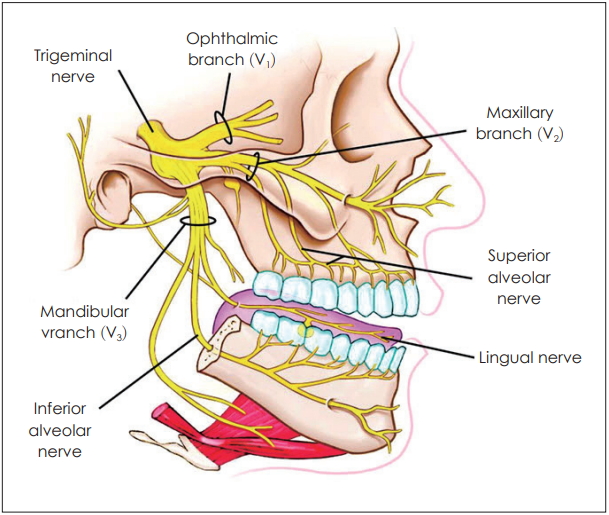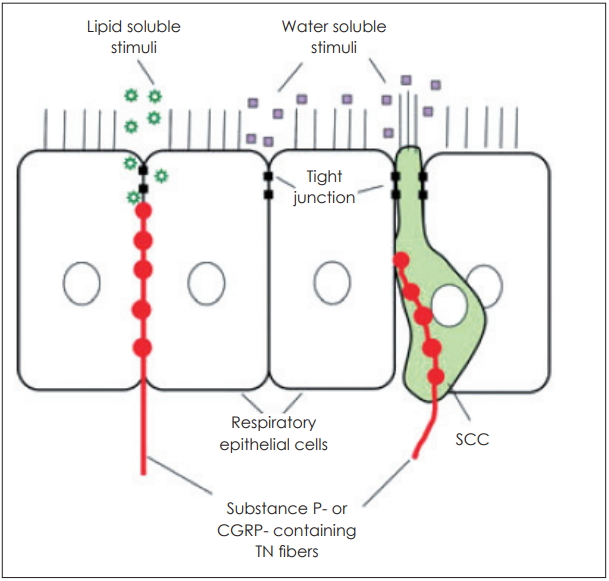ņä£ ļĪĀ
ļ╣äĻ░ĢņØĆ ĒøäĻ░üņŗĀĻ▓Į(olfactory nerve)Ļ│╝ ņé╝ņ░©ņŗĀĻ▓Į(trigeminal nerve), ļæÉ ļćīņŗĀĻ▓ĮņØś ņ¦Ćļ░░ļź╝ ļ░øĻ│Ā, ņØ┤ ļæÉ ņŗĀĻ▓ĮņØĆ ĒøäĻ░üļ¼╝ņ¦ł(odorant)Ļ│╝ ļ╣äņ×ÉĻĘ╣(nasal pungency; irritation)ņØä ņĀäļŗ¼ĒĢ£ļŗż. 19ņäĖĻĖ░ ņ┤łĻ╣īņ¦ĆļŖö ĒøäĻ░üņŗĀĻ▓ĮĻ│╝ ņé╝ņ░©ņŗĀĻ▓ĮņØś ņŚŁĒĢĀņØä ĻĄ¼ļČäĒĢśņ¦Ć ļ¬╗ĒĢśņśĆņŚłļŗż. ņØ┤Ēøä ĒøäĻ░üĻĖ░ļŖźņØĆ ņāüņŗżĒĢśņśĆņ£╝ļéś ļ╣äņ×ÉĻĘ╣ņØĆ ņØĖņ¦ĆĒĢśļŖö ņé¼ļĪĆļōżņØ┤ ļ│┤Ļ│ĀļÉśņŚłĻ│Ā, 1912ļģä Parker [1]Ļ░Ć ņ▓ÖņČöļÅÖļ¼╝ņØś ņĀÉļ¦ēņŚÉņä£ ļéśĒāĆļéśļŖö ĒøäĻ░üņØ┤ļéś ļ»ĖĻ░üņØ┤ ņĢäļŗī ĒÖöĒĢÖņĀü Ļ░ÉņØæņØä ŌĆ£common chemical senseŌĆØļØ╝Ļ│Ā ļ¬ģļ¬ģĒĢśļ®┤ņä£ ĒøäĻ░üĻ│╝ ļ╣äĻ░ĢņØś ņé╝ņ░©ņŗĀĻ▓Į ĒÖöĒĢÖņłśņÜ®ņØ┤ ĻĄ¼ļ│äļÉśĻĖ░ ņŗ£ņ×æĒĢśņśĆļŗż. 1990ļģä Green ļō▒[2]ņØĆ Ēö╝ļČĆņØś ņé╝ņ░©ņŗĀĻ▓ĮņØ┤ ĒåĄņ”Øļ┐É ņĢäļŗłļØ╝, ņ┤ēĻ░É, ņś©ļÅä Ļ░ÉĻ░ü Ļ░ÖņØĆ ļ╣äĒåĄņ”Ø Ļ░ÉĻ░ü ļ¬©ļæÉļź╝ ņĀäļŗ¼ĒĢ£ļŗżĻ│Ā ĒĢśņśĆņ£╝ļ®░ ņØ┤ļź╝ ŌĆ£ĒÖöĒĢÖĻ░ÉĻ░ü(chemesthesis)ŌĆØņØ┤ļØ╝Ļ│Ā ņ¢ĖĻĖēĒĢśņśĆļŗż. ņśżļŖśļéĀņŚÉļŖö ļīĆļČĆļČäņØś ĒøäĻ░üņä▒ ĒÖöĒĢÖļ¼╝ņ¦ł(odorous chemicals)ļōżņØ┤ ņ¦üĻ░äņĀæņĀüņ£╝ļĪ£ ļ╣äņĀäņĀĢ(nasal vestibule)Ļ│╝ ļ╣äĻ░ĢņŚÉ ņ£äņ╣śĒĢ£ ņé╝ņ░©ņŗĀĻ▓Į ļ¦Éļŗ©ņØä ņ×ÉĻĘ╣ņŗ£ņ╝£ Ļ░äņ¦Ćļ¤╝ņ”Ø, ļö░ļ£╗ĒĢ©, ņŗ£ņøÉĒĢ©, ņ░īļź┤ļŖö ļō»ĒĢ£ ļŖÉļéī ļō▒ņØä ļŖÉļü╝Ļ▓ī ļÉśļŖö Ļ▓āņ×äņØ┤ ļ░ØĒśĆņĪīļŗż[3].
ņØīņŗØņØ┤ļéś ĒÖöņןĒÆł ļō▒ņØś ļ╣äņ×ÉĻĘ╣ņØĆ ņóŗņØĆ ĻĖ░ļČäņØä ņØ╝ņ£╝Ēé¼ ņłś ņ׳Ļ│Ā ņØĖĻ░äņØś ĻĖ░ņ¢ĄĻ│╝ļÅä Ļ┤ĆļĀ©ņØ┤ ņ׳ļŗż. ļ░śļ®┤ņŚÉ Ļ│ĄĒĢ┤ ļ░Å ļÅģņä▒ ļ¼╝ņ¦ł Ļ░ÖņØĆ ļ╣äņ×ÉĻĘ╣ņŚÉ ļīĆĒĢ£ Ļ░Éņ¦Ćļź╝ ĒåĄĒĢ┤ ņÜ░ļ”¼ ļ¬ĖņØä ļ│┤ĒśĖ ļ░Å ļ░®ņ¢┤ĒĢĀ ņłś ņ׳ļŗż. ņØ┤ļĀćļō» ļ╣äĻ░ĢņØś ņé╝ņ░©ņŗĀĻ▓Į ĻĖ░ļŖźņØĆ ņØĖĻ░äņØś ņØ╝ņāüņāØĒÖ£ņŚÉ ĻĖ░ļŖźņĀüņ£╝ļĪ£ ņżæņÜöĒĢ©ņŚÉļÅä ļČłĻĄ¼ĒĢśĻ│Ā, ĒøäĻ░üņØ┤ļéś ļ»ĖĻ░üņŚÉ ļ╣äĒĢ┤ ņāüļīĆņĀüņ£╝ļĪ£ ļ¦ÄņØĆ Ļ│╝ĒĢÖņĀüņØĖ Ļ┤Ćņŗ¼ņØä ļ░øņ¦ĆļŖö ļ¬╗ĒĢ┤ņÖöļŗż. ļö░ļØ╝ņä£ ļ│Ė ņóģņäżņŚÉņä£ļŖö ĻĖ░ņĪ┤ ļ¼ĖĒŚīņØä Ļ▓ĆĒåĀĒĢśņŚ¼ ļ╣äĻ░Ģļé┤ņØś ņé╝ņ░©ņŗĀĻ▓ĮņØś ĒĢ┤ļČĆ ļ░Å ņāØļ”¼ļź╝ ņĀĢļ”¼ĒĢśĻ│Ā, ļ╣äņ×ÉĻĘ╣ņŚÉ ļīĆĒĢ£ ņé╝ņ░©ņŗĀĻ▓Į ĒÖöĒĢÖņłśņÜ®Ļ│╝ Ļ┤ĆļĀ©ĒĢ£ ņŚ░ĻĄ¼ļōżņŚÉ ļīĆĒĢśņŚ¼ ĻĖ░ņłĀĒĢśĻ│Āņ×É ĒĢ£ļŗż.
Anatomy and Physiology of the Trigeminal System
ņé╝ņ░©ņŗĀĻ▓ĮņØś Ļ░Ćņ¦Ć(branch)ņŚÉņä£ ļéśņś© Ļ░ÉĻ░üņŗĀĻ▓Į ļ¦Éļŗ©ņØĆ ņ¢╝ĻĄ┤ņØä ļŹ«ļŖö Ēö╝ļČĆ, ļ╣äĻ░Ģ ļ░Å ĻĄ¼Ļ░ĢņØś ņĀÉļ¦ē, ļłłĻ║╝ĒÆĆ ĻĘĖļ”¼Ļ│Ā Ļ░üļ¦ēņŚÉņä£ ļ░£Ļ▓¼ļÉ£ļŗż(Fig. 1). ņé╝ņ░©ņŗĀĻ▓ĮņØś ophthalmic divisionņØś nasociliary branchņŚÉņä£ ļéśņś© ethmoidal nerveĻ░Ć ļ╣äĻ░ĢņØś ņĀäņĖĪļ░®ņØä ņ¦Ćļ░░ĒĢśĻ│Ā, ņé╝ņ░©ņŗĀĻ▓ĮņØś maxillary divisionņØś branchņØĖ nasopalatine nerveĻ░Ć ļ╣äĻ░ĢņØś Ēøäļ®┤ņØä ņ¦Ćļ░░ĒĢ£ļŗż. ļ░£ņāØĒĢÖņĀüņ£╝ļĪ£ ņé╝ņ░©ņŗĀĻ▓ĮņØś ņŗĀĻ▓ĮņĀłĻ│╝ ņäĖ ļČäņ¦ĆļŖö Ēā£ņāØĻĖ░ 6ņŻ╝ņŚÉ ņØ┤ļ»Ė ņÖäņä▒ņØ┤ ļÉśĻ│Ā, ņŗĀņāØņĢäļŖö ņČ£ņāØ ņŗ£ņŚÉ ņØ┤ļ»Ė ņé╝ņ░©ņŗĀĻ▓ĮņØś ĒÖöĒĢÖņ×ÉĻĘ╣ņŚÉ ļ░śņØæĒĢ£ļŗż[4].
ņé╝ņ░©ņŗĀĻ▓ĮņŚÉņä£ļŖö ņŚ¼ļ¤¼ ņóģļźśņØś ņŗĀĻ▓Įņä¼ņ£ĀĻ░Ć ļ░£Ļ▓¼ļÉśļŖöļŹ░, ļ»ĖņäĖĒĢ£ unmyelinated(C) ļśÉļŖö small-diameter myelinated(A╬┤) fiberļŖö substance PņÖĆ calcitonin gene-related peptideļź╝ ĒżĒĢ©ĒĢśĻ│Ā ņ׳Ļ│Ā, Ēö╝ļČĆļ┐Éļ¦ī ņĢäļŗłļØ╝ ņĮöņÖĆ ĒśĖĒØĪĻĖ░ņŚÉņä£ņØś ņ×ÉĻĘ╣ ļ░śņØæņŚÉ Ļ┤ĆņŚ¼ĒĢ£ļŗż. ņé╝ņ░©ņŗĀĻ▓ĮņØś ņ£Āļ”¼ņóģļ¦É(free ending)ņØĆ ņĀÉļ¦ē ņāüĒö╝ Ēæ£ļ®┤ņØś ļ░öļĪ£ ņĢäļל, ņ”ē, 1 micrometer ņĢäļלņØś tight junction ņ£äņ╣śņŚÉ ņĪ┤ņ×¼ĒĢśĻ│Ā, ņØ┤ ņ£Āļ”¼ņóģļ¦ÉņŚÉļŖö ĒÖöĒĢÖņ×ÉĻĘ╣ņŚÉ ļ░śņØæĒĢśļŖö ļŗżņ¢æĒĢ£ ņłśņÜ®ņ▓┤ļōżņØ┤ ņ׳ļŗż. ĒŖ╣ņĀĢ ņłśņÜ®ņ▓┤Ļ░Ć ĒÖ£ņä▒ ļÉśļ®┤ ņØ┤Ēøä ņŚ¼ļ¤¼ ņØ┤ņś©ņ▒äļäÉļōżņØ┤ ņł£ņ░©ņĀüņ£╝ļĪ£ ņŚ┤ļ”¼ļ®┤ņä£ ĒāłļČäĻĘ╣ņØ┤ ņØ╝ņ¢┤ļéś ĒÖ£ņä▒ņĀäņ£ä(action potential)Ļ░Ć ļ░£ņāØĒĢśĻ▓ī ļÉ£ļŗż[5]. ļīĆĒæ£ņĀüņ£╝ļĪ£, C fiberņØś ņØ╝ļČĆ(subset)ņŚÉņä£ ļ░£Ļ▓¼ļÉśļŖö vanilloid ņłśņÜ®ņ▓┤ļŖö capsaicinņŚÉ Ļ░ĢĒĢ£ ņ╣£ĒÖöļÅäļź╝ Ļ░Ćņ¦ĆĻ│Ā ņ׳ņ¢┤ņä£ Ēö╝ļČĆļéś ņĀÉļ¦ēņŚÉ ĻĄŁņåī capsaicin ņ×ÉĻĘ╣ņØä ņŻ╝ļ®┤ burning painĻ│╝ ĒĢ©Ļ╗ś ņŻ╝ļ│Ć ņāüĒö╝ņäĖĒżņŚÉ ņŗĀĻ▓ĮņØĖņä▒ ņŚ╝ņ”Øļ░śņØæņØä ņØ╝ņ£╝Ēé©ļŗż[6]. ņØ┤ ņłśņÜ®ņ▓┤ļŖö ĒĢ┤ļĪ£ņÜ┤ ņŚ┤ņ×ÉĻĘ╣(noxious heat)Ļ│╝ ļŗżņ¢æĒĢ£ ņ¦Ćļ░®ņé░ ņ£ĀļÅäņ▓┤ņŚÉļÅä ļ░śņØæņØä ĒĢ£ļŗż[7,8].
SilverņÖĆ Finger [9]ļŖö ĒÖöĒĢÖļ¼╝ņ¦łņØ┤ ņ£Āļ”¼ņóģļ¦ÉņØä ņ×ÉĻĘ╣ĒĢśĻĖ░ ņ£äĒĢ┤ņä£ļŖö ņ×ÉĻĘ╣ ņ×ģņ×ÉĻ░Ć ļ╣äĻ░ĢņØä ĒåĄĻ│╝ĒĢ£ Ēøä ņĀÉļ¦ēņØä ĒåĄĻ│╝ĒĢ┤ ļČäņé░(diffuse)ļÉśĻ│Ā, ņāüĒö╝ņäĖĒżļ¦ēĻ│╝ ņäĖĒżĻ░ä(tight junction)ņØä ĒåĄĻ│╝ĒĢĀ ņłś ņ׳ņ¢┤ņĢ╝ ĒĢ£ļŗżĻ│Ā ĒĢśņśĆļŗż. ņĄ£ĻĘ╝ņŚÉļŖö ļ╣äĻ░ĢņØä ļ╣äļĪ»ĒĢśņŚ¼ ĻĖ░ļÅä ļ░Å ņåīĒÖöĻ┤ĆņŚÉļÅä ĒØ®ņ¢┤ņĀĖ ņ׳ļŖö ļ│ĆĒśĢļÉ£ ĒśĢĒā£ņØś ņāüĒö╝ņäĖĒżņØĖ solitary chemoreceptor cells(SCC)Ļ│╝ ņé╝ņ░© ĻĄ¼ņŗ¼ņä▒(afferent) ņŗĀĻ▓ĮņØ┤ ņä£ļĪ£ ņŗ£ļāģņŖż ĒĢśļŖö Ļ▓āņØ┤ ļ░£Ļ▓¼ļÉśņŚłļŗż[9-13]. ņ”ē, ņĀäĒåĄņĀüņ£╝ļĪ£ļŖö ĒÖöĒĢÖņ×ÉĻĘ╣ņØ┤ ņĮöņØś ņāüĒö╝ ļé┤ņŚÉ ņ׳ļŖö ņé╝ņ░©ņŗĀĻ▓ĮņØś ņ£Āļ”¼ņóģļ¦ÉņØä ņ¦üņĀæ ņ×ÉĻĘ╣ĒĢśļŖö Ļ▓āņ£╝ļĪ£ļ¦ī ņĢīļĀżņĪīņ¦Ćļ¦ī, ņé╝ņ░©ņŗĀĻ▓ĮĻ│╝ ĒĢ©Ļ╗ś ļ╣äĻ░Ģ ņĀäņ▓┤ņŚÉ ĒŹ╝ņĀĖ ņ׳ļŖö SCCĻ░Ć ņØ┤ņżæ ĒÖöĒĢÖĻ░Éņ¦Ćņ▓┤Ļ│ä(dual chemodetector systems)ļź╝ ņØ┤ļŻ©ļŖö Ļ▓āņ£╝ļĪ£ ņāØĻ░üļÉ£ļŗż(Fig. 2) [14].
Solitary chemoreceptor cellsņŚÉ ļīĆĒĢ£ ņŚ░ĻĄ¼ļōż
ņé╝ņ░©ņŗĀĻ▓ĮņØś ļ¦Éļŗ©ņŚÉļŖö ņĀäĻĖ░ņāØļ”¼ĒĢÖņĀüņØĖ Ļ▓Ćņé¼ņŚÉņä£ nicotineņŚÉ ņØśĒĢ┤ ņÜ®ļ¤ē ņØśņĪ┤ņĀü ņ×ģņ▓┤ņäĀĒāØ ĒÖ£ņä▒(dose dependent stereoselective activation)ņØä ļ│┤ņØ┤ļŖö nicotinic acetylcholine ņłśņÜ®ņ▓┤Ļ░Ć ņ׳ļŗż[15-17]. ņØ┤ nicotinic acetylcholine ņłśņÜ®ņ▓┤ļź╝ ļ¦ēņĢśņØä ļĢī SCC ļ¦żĻ░£ ņŗĀĻ▓ĮņØĖņä▒ ņŚ╝ņ”Øļ░śņØæņØ┤ ņśłļ░®ļÉśļŖöļŹ░, ņØ┤Ļ▓āņØĆ SCCĻ░Ć ņĮ£ļ”░ņä▒ ņŗĀĻ▓ĮņĀäļŗ¼ļ¼╝ņ¦łņØä ĒåĄĒĢ┤ ņé╝ņ░©ņŗĀĻ▓ĮņØä ņ×ÉĻĘ╣ņŗ£ņ╝£ņä£ ņŚ╝ņ”Øļ░śņØæņØ┤ ņØ╝ņ¢┤ļé£ļŗżļŖö Ļ▓āņØä ņØśļ»ĖĒĢ£ļŗż[14].
SCCļŖö ņé╝ņ░©ņŗĀĻ▓ĮņØś ņ£Āļ”¼ņóģļ¦ÉĻ│╝ļŖö ļŗżļź┤Ļ▓ī ļ»ĖĻ░ü ņłśņÜ®ņ▓┤ļź╝ Ļ░Ćņ¦ĆĻ│Ā ņ׳ļŗż. Tizzano ļō▒[13]ņØĆ ņé¼ļ×ī ņĮöņØś SCCņŚÉ ņō┤ļ¦ø ņłśņÜ®ņ▓┤(bitter taste receptor)Ļ░Ć ņĪ┤ņ×¼ĒĢ©ņØä ļ░ØĒśĆļāłļŗż. SCCļŖö ņé╝ņ░©ņŗĀĻ▓ĮĻ│╝ ņŚ░ņĀæĒĢ┤ ņ׳ņ£╝ļ»ĆļĪ£ ņō┤ļ¦ø ņłśņÜ®ņ▓┤ņØś ĒÖöĒĢÖņ×ÉĻĘ╣ņØä ļ»ĖĻ░üņ£╝ļĪ£ ļŖÉļü╝ņ¦Ć ņĢŖĻ│Ā irritation ļśÉļŖö ĒåĄņ”Øņ£╝ļĪ£ ļŖÉļü╝Ļ▓ī ļÉ£ļŗż[11]. ļśÉĒĢ£ ņō┤ļ¦ø ņłśņÜ®ņ▓┤ļŖö ĒÖöĒĢÖņ×ÉĻĘ╣ļ¦ī ņĢäļŗłļØ╝ bacteriaņŚÉļÅä ļ░śņØæĒĢśņŚ¼ biofilmņØä ĒśĢņä▒ĒĢśĻĖ░ ņĀäņŚÉ ņāüĒö╝ņäĖĒżņØś ņŚ╝ņ”Øļ░śņØæņØä ņ£ĀļÅäĒĢśļŖö ņŚŁĒĢĀņØä ĒĢ£ļŗż[18].
ņźÉļź╝ ļīĆņāüņ£╝ļĪ£ ĒĢ£ ņŚ░ĻĄ¼ņŚÉņä£ļŖö ļ╣äĻ░Ģņ£╝ļĪ£ ļōżņ¢┤Ļ░ĆļŖö ņ×ģĻĄ¼ņŚÉ SCCĻ░Ć ņĪ░ļ░ĆĒĢśĻ▓ī ņ£äņ╣śĒĢśĻ│Ā, Ļ│╝ļÅäĒĢ£ ļ╣äņ×ÉĻĘ╣ ļ░Å ņ£ĀĒĢ┤ ļ¼╝ņ¦łņØś ņĀæĻĘ╝ņØä ņĀ£ĒĢ£ĒĢśļŖö ļŹ░ņŚÉ ņżæņÜöĒĢ£ ņŚŁĒĢĀņØä ĒĢ£ļŗżļŖö Ļ▓āņØä ļ░ØĒśöļŗż[19]. ļśÉĒĢ£ ņé╝ņ░©ņŗĀĻ▓Į ņä¼ņ£Āļź╝ ņĀ£Ļ▒░ĒĢ£ ņźÉ ļ¬©ļŹĖņŚÉņä£ SCCņØś ļČäĒÖö ļ░Å ņāØņĪ┤ņØĆ ņé╝ņ░©ņŗĀĻ▓Į ņä¼ņ£ĀņØś ņśüĒ¢źņØä ļ░øņ¦Ć ņĢŖĻ│Ā ļÅģļ”ĮņĀüņ×äņØä ņĢī ņłś ņ׳ņŚłļŗż[20].
ņØ┤ņ▓śļ¤╝ SCCļŖö ņé╝ņ░©ņŗĀĻ▓Į Ļ░ÉĻ░üņŚÉ ļ│┤ņĪ░ņĀüņØĖ ņŚŁĒĢĀņØä ĒĢśļ®┤ņä£ ļÅģņ×ÉņĀüņØĖ ĒŖ╣ņ¦ĢļōżļÅä Ļ░Ćņ¦ĆĻ│Ā ņ׳ļŗż. ļ╣äĻ░Ģ ņ¦łĒÖśņØś ļ│æĒā£ ņāØļ”¼ņÖĆņØś ņŚ░Ļ┤Ćņä▒Ļ│╝ Ļ┤ĆļĀ©ĒĢśņŚ¼ SCCņØś ņŚŁĒĢĀņŚÉ ļīĆĒĢ£ ņŚ░ĻĄ¼ļŖö ņĢ×ņ£╝ļĪ£ļÅä ņ¦äĒ¢ēļÉĀ Ļ▓āņØ┤ļØ╝ ņśłņāüļÉ£ļŗż.
Chemosensory Trigeminal Stimulation
ņłśļ¦ÄņØĆ Ē£śļ░£ņä▒ ĒÖöĒĢÖļ¼╝ņ¦ł(volatile chemicals)ļōżņØĆ ņĀĢĻĄÉĒ׳ ļ¦×ņČ░ņ¦ä ņé╝ņ░©ņŗĀĻ▓Į ņłśņÜ®ņ▓┤ņŚÉ ļ░śņØæĒĢ£ļŗż. ņØ┤ļōżņØĆ ņ¢┤ļŖÉ ļåŹļÅä ņØ┤ņāüņŚÉņä£ ļ¬©ļæÉ ņĮöņÖĆ ļłłņŚÉ ņ×ÉĻĘ╣ņØä ņżä ņłś ņ׳ļŗż. Ē£śļ░£ņä▒ ĒÖöĒĢÖļ¼╝ņ¦łņØĆ ņé╝ņ░©ņŗĀĻ▓ĮņØä ņ×ÉĻĘ╣ĒĢśņŚ¼ 1) ĒśĖĒØĪņØ┤ļéś ļ╣äļČäļ╣ä(nasal secretion)ņŚÉ ļ│ĆĒÖöļź╝ ņŻ╝Ļ▒░ļéś 2) cooling, burning, irritation, pain ļō▒ņØä ņØĖņ¦ĆĒĢśĻ▓ī ĒĢśĻ▒░ļéś 3) ĒøäĻ░üņŗĀĻ▓ĮņØś ļāäņāł ņØĖņ¦ĆņŚÉ ņśüĒ¢źņØä ļü╝ņ╣£ļŗż[3].
ņł£ņłśĒĢ£ ĒøäĻ░üņ×ÉĻĘ╣ļ¼╝ņ¦łĻ│╝ ņé╝ņ░©ņŗĀĻ▓Į ņ×ÉĻĘ╣ņŚÉ ļīĆĒĢ£ ņŚ░ĻĄ¼
ņł£ņłśĒĢ£(pure) ĒøäĻ░ü ņ×ÉĻĘ╣ļ¼╝ņ¦łņØ┤ļ×Ć ņ¢┤ļ¢ż ļåŹļÅäņŚÉņä£ļÅä ņé╝ņ░©ņŗĀĻ▓ĮņØä ņ×ÉĻĘ╣ņŗ£Ēéżņ¦Ć ņĢŖļŖö ļāäņāłļĪ£ņä£ ņØĖĻ░äņØś ĒøäĻ░üņŚ░ĻĄ¼ņŚÉ ļ¦żņÜ░ ņżæņÜöĒĢśļŗż. Ļ╣©ļüŚĒĢ£ Ļ│ĄĻĖ░ņĪ░ņ░© ĒØÉļ”äņåŹļÅä(flow rate), ņś©ļÅä, ņŖĄļÅäņŚÉ ļö░ļØ╝ ņé╝ņ░©ņŗĀĻ▓ĮņØä ņ×ÉĻĘ╣ĒĢĀ ņłś ņ׳ņ¦Ćļ¦ī, ņ¢┤ļ¢ż ĒÖöĒĢÖļ¼╝ņ¦łņØĆ Ļ╣©ļüŚĒĢ£ Ļ│ĄĻĖ░ ņØ┤ņāüņ£╝ļĪ£ ņé╝ņ░©ņŗĀĻ▓ĮņØä Ļ▒░ņØś ņ×ÉĻĘ╣ĒĢśņ¦Ć ņĢŖĻ▒░ļéś, ņ×ÉĻĘ╣ņØ┤ ņŚåļŖö Ļ▓āņ£╝ļĪ£ ņĢīļĀżņĪīļŗż. 1925ļģä von Skramlik [21]ņØĆ anethole, cadinene( juniper), eugenol, geraniol, indole, limonene, phenyl ethyl alcohol, pinene, skatol, terpineolņØä ĒżĒĢ©ĒĢśņŚ¼ ņĢĮ 50Ļ░Ćņ¦ĆņØś ņł£ņłśĒĢ£ ĒøäĻ░üņ×ÉĻĘ╣ ļ¼╝ņ¦łņØä ņĀ£ņŗ£ĒĢśņśĆļŗż. 1975ļģä Doty [22]Ļ░Ć ļ¼┤ĒøäĻ░üņ”Ø ĒÖśņ×Éļź╝ ĒåĄĒĢ┤ ņĢīņĢäļéĖ 11Ļ░Ćņ¦Ć ņł£ņłśĒĢ£ ĒøäĻ░üņ×ÉĻĘ╣ ļ¼╝ņ¦ł ņŚŁņŗ£ von Skramlik [21]Ļ░Ć ņĀ£ņŗ£ĒĢ£ Ļ▓āĻ│╝ ļīĆļČĆļČä ņØ╝ņ╣śĒĢśņśĆņ£╝ļéś, ņØ┤ Ēøä ņ¦äĒ¢ēļÉ£ ņŚ░ĻĄ¼ņŚÉņä£ļŖö ņł£ņłśĒĢ£ ĒøäĻ░üņ×ÉĻĘ╣ ļ¼╝ņ¦łņØ┤ļØ╝Ļ│Ā ņāØĻ░üļÉśņŚłļŹś ņØ┤ļōż ņżæ ļīĆļČĆļČäņØä ņØ╝ļČĆ ļ¼┤ĒøäĻ░üņ”Ø ĒÖśņ×Éļéś ņé╝ņ░©Ļ░ÉĻ░üņŚÉ ņ¦æņżæĒĢ£ Ēö╝ĒŚśņ×ÉļōżņØ┤ Ļ░Éņ¦ĆĒĢśļŖö Ļ▓āņØä ĒÖĢņØĖĒĢśņśĆļŗż[23].
von Skramlik [21]ņØĆ ĒøäĻ░üņŗĀĻ▓ĮĻ│╝ ņé╝ņ░©ņŗĀĻ▓ĮņØä ĒĢ©Ļ╗ś ņ×ÉĻĘ╣ņŗ£ĒéżļŖö ņł£ņłśĒĢśņ¦Ć ņĢŖņØĆ(impure) ļ¼╝ņ¦łļÅä ļČäļźśĒĢśņśĆļŗż. ļāäņāłņÖĆ ļŗ¼ņĮżĒĢ£ ļŖÉļéīņØ┤ ļéśļŖö ļ¼╝ņ¦ł(bromoform, chloroform, ethyl chloride, iodoform, nitrobenzol), ļāäņāłņÖĆ ņŗĀ ļŖÉļéīņØ┤ ļéśļŖö ļ¼╝ņ¦ł(acetic acid, butyric acid, propionic acid, valerianic acid), ļāäņāłņÖĆ ņŗ£ņøÉĒĢ£ ļŖÉļéīņØ┤ ļéśļŖö ļ¼╝ņ¦ł(camphor, eucalyptol, menthol, phenol, safrol), ļāäņāłņÖĆ ļö░ļ£╗ĒĢ£ ļŖÉļéīņØ┤ ļéśļŖö ļ¼╝ņ¦ł(ethanol, pentanol, propanol), ĻĘĖļ”¼Ļ│Ā ļāäņāłņÖĆ ĒåĄņ”Ø ļśÉļŖö ņ░īļź┤ļŖö ļŖÉļéīņØ┤ ļéśļŖö ĒøäĻ░üļ¼╝ņ¦ł(acetone, acetic acid, ammonia, bromine, chlorine, formic acid, iodine, nicotine, pyridine, SO2, thiophene, tolol, xylol)ņØ┤ ņ׳ļŗżĻ│Ā ļ│┤Ļ│ĀĒĢśņśĆļŗż[21]. ņĄ£ĻĘ╝ ņ£ĀĒĢ┤ĒÖśĻ▓ĮĻ│╝ Ļ┤ĆļĀ©ĒĢśņŚ¼ ņżæņÜöņŗ£ļÉśļŖö Ē£śļ░£ņä▒ ņ£ĀĻĖ░ ĒÖöĒĢ®ļ¼╝(volatile organic compounds, VOCs)ņØś ļīĆļČĆļČäņØĆ ņ×ÉĻĘ╣ņØä ņŻ╝ļŖö ņĪ░Ļ▒┤Ļ│╝ ļåŹļÅäņŚÉ ļö░ļØ╝ ĒøäĻ░üņŗĀĻ▓ĮĻ│╝ ņé╝ņ░©ņŗĀĻ▓ĮņØä ļ¬©ļæÉ ņ×ÉĻĘ╣ĒĢśļŖö Ļ▓āņ£╝ļĪ£ ļ░ØĒśĆņĪīļŗż[3].
ļ╣äĻ░ĢņŚÉņä£ ņé╝ņ░©ņŗĀĻ▓ĮņØś ņŚŁņ╣ś ļ░śņØæņŚÉ ļīĆĒĢ£ ņŚ░ĻĄ¼
ņŚ¼ļ¤¼ ņŚ░ĻĄ¼ļōżņØä ĒåĄĒĢ┤ ĒøäĻ░üĻ│äĻ░Ć ņé╝ņ░©ņŗĀĻ▓ĮĻ│äļ│┤ļŗż ļŹö ņśłļ»╝ĒĢ©ņØ┤ ĒÖĢņØĖļÉśņŚłļŗż[23,24]. ņ”ē, ņ▓śņØīņŚÉļŖö ļāäņāłļ¦ī Ļ░Éņ¦ĆĒĢśļŗżĻ░Ć ĒÖöĒĢÖ ļ¼╝ņ¦łņØś ļåŹļÅäĻ░Ć ņ”ØĻ░ĆĒĢĀņłśļĪØ ņé╝ņ░©ņŗĀĻ▓ĮņØś ĒÖöĒĢÖĻ░ÉĻ░üņØä ĒĢ©Ļ╗ś ļŖÉļü╝ļŖö ņ¦ĆņĀÉņØ┤ ļ░£ņāØĒĢ£ļŗż. ļśÉĒĢ£ ļæÉ ņŗĀĻ▓ĮņØ┤ ĒĢ©Ļ╗ś ņ×ÉĻĘ╣ļÉśļ®┤ ĒøäĻ░ü ņ×ÉĻĘ╣ņØ┤ ņé╝ņ░©ņŗĀĻ▓Į ņ×ÉĻĘ╣ņŚÉ ļīĆĒĢ£ ļ░śņØæņØä ļ░®ĒĢ┤ĒĢśļŖö ĒøäĻ░ü Ļ░äņäŁņØ┤ ļ░£ņāØĒĢśĻ▓ī ļÉ£ļŗż. ļö░ļØ╝ņä£ ļ╣äĻ░ĢņŚÉņä£ ņé╝ņ░©ņŗĀĻ▓Į ĒÖöĒĢÖĻ░ÉĻ░üņØś ņŚŁņ╣śļź╝ ĒÖĢņØĖĒĢĀ ļĢīņŚÉļŖö ļ¼┤ĒøäĻ░üņ”Ø ĒÖśņ×Éļź╝ ļīĆņāüņ£╝ļĪ£ ņĖĪņĀĢĒĢ┤ņĢ╝ ĒĢ£ļŗż[24].
ĒøäĻ░ü Ļ░äņäŁņØä ņĀ£ņÖĖĒĢ£ ņé╝ņ░©ņŗĀĻ▓Į Ļ░ÉĻ░ü ņŚ░ĻĄ¼ļŖö ņĢłņĀÉļ¦ē(ocular mucosa) ņ×ÉĻĘ╣ņØä ņØ┤ņÜ®ĒĢśņŚ¼ ņŗ£Ē¢ēĒĢĀ ņłśļÅä ņ׳ļŗż[25]. ņĮöņÖĆ ļłłņØś ņé╝ņ░©ņŗĀĻ▓Į ĒÖöĒĢÖ Ļ░Éņłśņä▒ņØĆ ļīĆņ▓┤ņĀüņ£╝ļĪ£ ņ£Āņé¼ĒĢśļŗż[26]. ĒŖ╣ņĀĢ ĒÖöĒĢÖļ¼╝ņ¦łņØ┤ļéś ĒŖ╣ņĀĢ ņĪ░Ļ▒┤ņŚÉņä£ļŖö ļłłņŚÉņä£ņØś ļ░śņØæņØ┤ ņĮöļ│┤ļŗż ļŹ£ĒĢśĻ▒░ļéś ļŹö ĒĢĀ ņłśļÅä ņ׳ņ£╝ļéś ļłłĻ│╝ ņĮöņŚÉņä£ņØś ņé╝ņ░©ņŗĀĻ▓Į Ļ░ÉĻ░üņØś Ļ░Éņłśņä▒ ņ░©ņØ┤ļŖö ĒøäĻ░üĻ│╝ ņĮöņØś ņé╝ņ░©ņŗĀĻ▓Į Ļ░ÉĻ░üņØś Ļ░Éņłśņä▒ ņ░©ņØ┤ļ│┤ļŗżļŖö Ēø©ņö¼ ņ×æņØĆ Ļ▓āņ£╝ļĪ£ ņĢīļĀżņĀĖ ņ׳ļŗż[27].
ļÅģņä▒ĒĢÖ(toxicology)ņŚÉņä£ļŖö ĒøäĻ░üņŗĀĻ▓ĮĻ│╝ ņé╝ņ░©ņŗĀĻ▓ĮņØä ļ¬©ļæÉ ņ×ÉĻĘ╣ĒĢśļŖö VOCsņØś ņ×ÉĻĘ╣ ņĀĢļÅä(degree), ņ¢æ(dose) ļō▒ņØ┤ ņżæņÜöĒĢ£ ņØ┤ņŖłņØ┤ļŗż. ļāäņāłļź╝ ņØĖņ¦ĆĒĢśļŖö ņĄ£ņåīļåŹļÅä, ņé╝ņ░©ņŗĀĻ▓Į ņ×ÉĻĘ╣ņØä ņØĖņ¦ĆĒĢśļŖö ņĄ£ņåīļåŹļÅä, ļæÉ Ļ░Ćņ¦Ć ļ¬©ļæÉ ļŖÉļü╝ļŖö ņĄ£ņåīļåŹļÅä ļō▒ņ£╝ļĪ£ ĻĄ¼ļ│äĒĢśņŚ¼, Ē¢źņłśņĀ£ņĪ░, ņØīņŗØ, ņŗżļé┤Ļ│ĄĻĖ░ ņ¦ł(indoor air quality) ĒÅēĻ░ĆņŚÉ ļ¦żņÜ░ ņ£ĀņÜ®ĒĢ£ ņĀĢļ│┤ļź╝ ņĀ£Ļ│ĄĒĢ£ļŗż. ĒĢśņ¦Ćļ¦ī ļ¦ÄņØĆ VOCs Ļ┤ĆļĀ© ņŚ░ĻĄ¼ļōżņŚÉņä£ ņé¼ņÜ®ĒĢśļŖö Ļ░ĢņĀ£ ņäĀĒāØņĀü ņĀĢņŗĀļ¼╝ļ”¼ĒĢÖņĀü Ļ▓Ćņé¼(forced-choice psychophysical test)ļĪ£ļŖö ņĀĢĒÖĢĒĢ£ ņŚŁņ╣śļź╝ ĒÖĢņØĖĒĢśļŖö ļŹ░ņŚÉ ĒĢ£Ļ│äĻ░Ć ņ׳ļŗż.
ļÅÖņóģ ĒÖöĒĢ®ļ¼╝ņØś ļåŹļÅäņŚÉ ļö░ļźĖ ņé╝ņ░©ņŗĀĻ▓ĮņØś ļ░śņØæ
ļÅÖņóģ ĒÖöĒĢ®ļ¼╝(homologous chemicals)ņŚÉņä£ ļŗżļźĖ ļåŹļÅäņØś ņ×ÉĻĘ╣ņŚÉ ņØśĒĢ£ ĒøäĻ░üĻ│╝ ņé╝ņ░©ņŗĀĻ▓ĮņØś ņŚ░ņåŹņĀüņØĖ ņŚŁņ╣śļź╝ ņĪ░ņé¼ĒĢ£ ņŚ░ĻĄ¼ņŚÉņä£, ĒøäĻ░üņØ┤ ņé╝ņ░©Ļ░ÉĻ░üļ│┤ļŗż ņāüļīĆņĀüņ£╝ļĪ£ ļ╣ĀļźĖ ļ│ĆĒÖöļź╝ ļ│┤ņśĆĻ│Ā, ļæÉ Ļ░ÉĻ░üņŚÉņä£ ļ¬©ļæÉ carbon chainņØ┤ ĻĖĖņ¢┤ņ¦łņłśļĪØ ņŚŁņ╣śĻ░Ć ļé«ņĢäņĪīļŗż(Fig. 3) [24]. ļśÉĒĢ£ carbon chainņØ┤ ĻĖĖņ¢┤ņ¦łņłśļĪØ ĒøäĻ░ü ņŚŁņ╣śņÖĆ ņé╝ņ░©ņŗĀĻ▓Į ņŚŁņ╣śņØś ņ░©ņØ┤ļŖö ļŹöņÜ▒ ņ”ØĻ░ĆĒĢśņśĆļŗż[28].
ĒÖöĒĢÖ Ēś╝ĒĢ®ļ¼╝ņŚÉ ļīĆĒĢ£ ņé╝ņ░©ņŗĀĻ▓ĮĻ│äņØś ļ░śņØæ
ņØ╝ņāüņāØĒÖ£ņŚÉņä£ ĒÖöĒĢÖņĀü Ļ░ÉĻ░üņØĆ ļ│ĄĒĢ®ņĀüņØĖ ņä▒ļČäņØ┤ Ēś╝ĒĢ®ļÉ£ ņāüĒā£ļĪ£ ņ×ÉĻĘ╣ļÉśļ®░, ņØ┤ļŖö ņé╝ņ░©ņŗĀĻ▓ĮĻ│äļÅä ļ¦łņ░¼Ļ░Ćņ¦ĆņØ┤ļŗż. ĻĘĖļ¤¼ļéś ĒÖöĒĢÖĒś╝ĒĢ®ļ¼╝(chemical mixture)ņŚÉ ļīĆĒĢ┤ ņé╝ņ░©ņŗĀĻ▓ĮĻ│äĻ░Ć ļ░śņØæĒĢśļŖö ņøÉļ”¼ļŖö ņĢäņ¦ü ļ¦ÄņØ┤ ņĢīļĀżņ¦ä ļ░öĻ░Ć ņŚåļŗż. ņÅśļŖö ļō»ĒĢ£(pungent) ņ×ÉĻĘ╣ņØ┤ ņ׳ļŖö 4ļŗ©Ļ│ä ļåŹļÅäņØś formaldehydeņÖĆ ammoniaļź╝ ņä×ņØĆ Ēś╝ĒĢ®ļ¼╝ļōżņØä ļ╣äĻĄÉĒĢ£ ņŚ░ĻĄ¼ņŚÉņä£ ņĀĆ, ņżæ, Ļ│ĀļåŹļÅäļĪ£ ļ│ĆĒĢ©ņŚÉ ļö░ļØ╝ Ēś╝ĒĢ®ļ¼╝ņØś ņ┤Ø ņØĖņ¦Ć Ļ░ĢļÅäļŖö ņĀĆĻ░Ćņé░ņä▒(hypoadditivity), ļŗ©ņł£ Ļ░Ćņé░ņä▒(simple additivity), Ļ│ĀĻ░Ćņé░ņä▒(hyperadditivity)ņ£╝ļĪ£ ļéśĒāĆļé£ļŗżļŖö Ļ▓āņØ┤ ļ░ØĒśĆņ¦ä ļ░ö ņ׳ļŗż[29]. ņ”ē, ļæÉ ņä▒ļČäņØś ļåŹļÅäĻ░Ć ņ”ØĻ░ĆĒĢĀņłśļĪØ ĻĘĖ Ēś╝ĒĢ®ļ¼╝ņØĆ Ļ░üĻ░üņØś ņä▒ļČäņŚÉ ļīĆĒĢ£ ņ×ÉĻĘ╣ņØä ĒĢ®ņ╣£ Ļ▓āļ│┤ļŗż ļŹö ļåÆņØĆ Ļ░ĢļÅäņØś ļ░śņØæņØä ļ│┤ņØĖļŗżļŖö Ļ▓āņØ┤ļŗż. ņØ┤ Ļ▓░Ļ│╝ļŖö ņé╝ņ░©ņŗĀĻ▓ĮĻ│äĻ░Ć ņĀÉņ░©ņĀüņ£╝ļĪ£ ļ¦ÄņØĆ Ļ░£ņ×ģņØä ĒĢ£ļŗżļŖö ņĀÉņØä ļ│┤ņŚ¼ņżĆļŗż. Ļ░ÖņØĆ ņä▒ļČäĻ│╝ Ēś╝ĒĢ®ļ¼╝ņØä ņØ┤ņÜ®ĒĢ£ ĒøäņåŹ ņŚ░ĻĄ¼ņŚÉņä£ļŖö, ņŻ╝ņ¢┤ņ¦ĆļŖö ņ×ÉĻĘ╣ņŚÉ ļīĆĒĢ┤ Ēö╝ĒŚśņ×ÉĻ░Ć ĒøäĻ░ü ņ×ÉĻĘ╣Ļ│╝ ņé╝ņ░©ņŗĀĻ▓Į ņ×ÉĻĘ╣ņ£╝ļĪ£ ĻĘĖ ņåŹņä▒ņØä ĻĄ¼ļČäĒĢśļÅäļĪØ ĒĢśņśĆļŗż. ĻĘĖ Ļ▓░Ļ│╝ ĒøäĻ░ü ņ×ÉĻĘ╣ņØĆ Ēś╝ĒĢ®ļ¼╝ņŚÉņä£ ĒĢŁņāü ņĀĆĻ░Ćņé░ņä▒ņØä ļ│┤ņśĆņ£╝ļéś, ņé╝ņ░©ņŗĀĻ▓Į ņ×ÉĻĘ╣ņØĆ ņŻ╝ļĪ£ Ļ░Ćņé░ņä▒ņØä ļ│┤ņśĆĻ│Ā Ļ│ĀĻ░Ćņé░ņä▒ņØä ļ│┤ņØĖ Ļ▓ĮņÜ░ļÅä ņ׳ņŚłļŗż[30].
Commetto-Mun~iz ļō▒[31,32]ņØĆ ĒøäĻ░üņŗĀĻ▓Į ļ░Å ņé╝ņ░©ņŗĀĻ▓ĮņØś ņ×ÉĻĘ╣ļ░śņØæņØä ĒÖöĒĢÖļ¼╝ņ¦łņØś ļåŹļÅä ļŗ©ņ£äļĪ£ ļ│ĆĒÖśņŗ£ĒéżĻ│Ā Ēś╝ĒĢ®ļ¼╝ņØä ĻĄ¼ņä▒ĒĢśļŖö ņä▒ļČä ļ¼╝ņ¦łņØś ņāüļīĆņĀü ļ╣äņ£©ņØä ļ╣äĻĄÉĒĢ©ņ£╝ļĪ£ņŹ©, Ēś╝ĒĢ®ļ¼╝ ņĢłņØś ņä▒ļČä ļ¼╝ņ¦łņØś ļåŹļÅäļź╝ ņĢīņĢäļé┤ņŚłļŗż. ļśÉĒĢ£ ņŚŁņ╣śņłśņżĆ(perithreshold)ņØś Ēś╝ĒĢ®ļ¼╝ņŚÉņä£ļŖö Ēś╝ĒĢ®ļ¼╝ņØś ĻĄ¼ņä▒ ņÜöņåī Ļ░äņŚÉ ņāüĒśĖ ņ¢ĄņĀ£Ļ░Ć ņŚåņØīņØä ļ░ØĒśöļŗż.
ĒøäĻ░üĻ│äņÖĆ ņé╝ņ░©ņŗĀĻ▓ĮĻ│äņØś ņĀĢņŗĀļ¼╝ļ”¼ņĀü ņāüĒśĖņ×æņÜ®
ĒøäĻ░üĻ│äņÖĆ ņé╝ņ░©ņŗĀĻ▓ĮĻ│äļŖö ņāØļ”¼ņĀüņØĖ ņāüĒśĖņ×æņÜ®ņØä ĒĢ£ļŗż. 1868ļģäņŚÉ Alexander BainņØĆ ŌĆ£ļ¦īņĢĮ Ēāäņé░ ĒØÉļ”ä(current)ņØ┤ ļāäņāł ņ×ÉĻĘ╣Ļ│╝ ļ¦łņŻ╝ņ╣śĻ▓ī ļÉśļ®┤, ļāäņāł ņ×ÉĻĘ╣ņØĆ ņé¼ļØ╝ņ¦äļŗżŌĆØļØ╝ ļ│┤Ļ│ĀĒĢśņśĆĻ│Ā, 1930ļģä KatzņÖĆ Talbert [33]ļŖö ĒøäĻ░üĻ│╝ ĒåĄĻ░ü ņä▒ļČäņØä ļ¬©ļæÉ Ļ░Ćņ¦ä ļāäņāłļź╝ ļåÆņØĆ ļåŹļÅäļĪ£ ņŻ╝ņŚłņØä ļĢī, ĒåĄĻ░ü ņä▒ļČäņØ┤ ņÜ░ņ£äļź╝ ņ░©ņ¦ĆĒĢśļŖö Ļ▓āņØä ļ░ØĒśöļŗż. ņØ┤ļŖö ņé╝ņ░©ņŗĀĻ▓ĮņØ┤ ĒøäĻ░üņŗĀĻ▓Įņ£╝ļĪ£ ņĀäļŗ¼ļÉśļŖö ņ×ÉĻĘ╣ņØä ņ░©ĒÅÉĒĢ£ļŗżļŖö ņé¼ņŗżņØä ņŗ£ņé¼ĒĢ£ļŗż.
CainĻ│╝ Murphy [34]ļŖö Ļ░ü 4ļŗ©Ļ│ä ļåŹļÅäņØś n-amyl butyrateņÖĆ CO2ļź╝ Ēś╝ĒĢ®ĒĢ£ ņ┤Ø 16Ļ░Ćņ¦ĆņØś Ēś╝ĒĢ®ļ¼╝ņØä ņØ┤ņÜ®ĒĢśņŚ¼ Ēö╝ĒŚśņ×ÉĻ░Ć ņČöņĀĢĒĢśļŖö ņĀäļ░śņĀüņØĖ Ļ░ÉĻ░ü Ļ░ĢļÅäņÖĆ ļāäņāłņÖĆ ĒåĄĻ░ü Ļ░ĢļÅäļź╝ ļéśļłäņ¢┤ Ēæ£ņŗ£ĒĢśļÅäļĪØ ĒĢśņśĆļŗż. ļśÉĒĢ£ ņØ┤ņ¢┤ņ¦ĆļŖö ņŗ£ĒŚśņŚÉņä£ Ēö╝ĒŚśņ×ÉņØś ĒĢ£ņ¬Į ņĮ¦ĻĄ¼ļ®ŹņŚÉņä£ CO2ļź╝ ņ×ÉĻĘ╣ĒĢśņśĆĻ│Ā, ļŗżļźĖ ņ¬Į ņĮ¦ĻĄ¼ļ®ŹņŚÉļŖö n-amyl butyrateļź╝ ņ×ÉĻĘ╣ĒĢśņśĆļŗż. ļæÉ ņŗ£ĒŚś Ļ▓░Ļ│╝ ļ¬©ļæÉņŚÉņä£ n-amyl butyrateņØś ņ×ÉĻĘ╣ņØ┤ CO2ļĪ£ ņØĖĒĢ┤ ņ¢ĄņĀ£ļÉśļŖö Ļ▓āņ£╝ļĪ£ ļ░ØĒśĆņĪīļŗż. ņØ┤ļŖö ņżæņČöņŗĀĻ▓ĮĻ│äņŚÉņä£ ĒøäĻ░üĻ│äņÖĆ ņé╝ņ░©ņŗĀĻ▓ĮĻ│äņØś ņāüĒśĖņ×æņÜ®ņØ┤ ņØ┤ļŻ©ņ¢┤ņ¦äļŗżļŖö ņĀÉņØä ņŗ£ņé¼ĒĢ£ļŗż. ļö░ļØ╝ņä£ ĒŖ╣ņĀĢ ĒÖöĒĢÖ ļ¼╝ņ¦ł ļśÉļŖö Ēś╝ĒĢ®ļ¼╝ņŚÉ ļīĆĒĢ£ ļ░śņØæņØä ņśłņĖĪĒĢĀ ļĢīļŖö ĒøäĻ░üĻ│äņÖĆ ņé╝ņ░©ņŗĀĻ▓ĮĻ│äņØś ņāüĒśĖņ×æņÜ®ņ£╝ļĪ£ ņØĖĒĢ£ ņ¢ĄņĀ£ Ēī©Ēä┤ņŚÉ ļīĆĒĢ£ ņØ┤ĒĢ┤Ļ░Ć ņäĀĒ¢ēļÉśņ¢┤ņĢ╝ ĒĢ£ļŗż.
ņĀĢņŗĀļ¼╝ļ”¼ĒĢÖņĀü ņĖĪņĀĢņØś ĒÖśĻ▓ĮņĀü ņĀüņÜ®
ņ£ĀĒĢ┤ĒÖśĻ▓Į ļģĖņČ£ņØĆ Ēü¼Ļ▓ī ņ¦üņŚģņĀü(ņé░ņŚģņĀü) ļģĖņČ£Ļ│╝ ņŻ╝Ļ▒░ņĀü(ļ╣äņé░ņŚģņĀü) ļģĖņČ£ļĪ£ ļéśļłī ņłś ņ׳ļŗż. American Conference of Industrial HygienistsņŚÉ ļö░ļź┤ļ®┤ ņé░ņŚģņĀü ņ£ĀĒĢ┤ĒÖśĻ▓Į ļģĖņČ£ņŚÉņä£ 40%ņØś ĒŚłņÜ®ĒĢ£Ļ│äņĀÉ(threshold limit values, TLVs)ņØĆ Ļ░ÉĻ░üĻ│äņØś ņ×ÉĻĘ╣ ņĀĢļÅäņŚÉ ļö░ļźĖ Ļ▓āņ£╝ļĪ£, ņØ┤ļŖö ļłłĻ│╝ ņĮö, ļ¬®ņØś ņ×ÉĻĘ╣ņØä ĒżĒĢ©ĒĢ£ļŗż[35]. ņé░ņŚģņĀü ņ£ĀĒĢ┤ĒÖśĻ▓Į ļģĖņČ£ņØĆ Ļ░ü ņé░ņŚģņ▓┤ņŚÉņä£ ņé¼ņÜ®ĒĢśļŖö ļ¼╝ņ¦łĻ│╝ ņāØņé░ļ▓ĢņŚÉ ļö░ļØ╝ ņóīņÜ░ļÉśļ®░, ļ¼ĖņĀ£ļź╝ ņØ╝ņ£╝ĒéżļŖö Ļ▓āņØ┤ ļ│äĻ░£ņØś ņä▒ļČäņ£╝ļĪ£ ņØĖĒĢ£ Ļ▓āņØĖņ¦Ć, Ēś╝ĒĢ®ļ¼╝ļĪ£ ņØĖĒĢ£ Ļ▓āņØĖņ¦Ć, ņØśņŗØĒĢĀ ņłś ņ׳ļŖö ņĀĢļÅäņØś ļāäņāłĻ░Ć ļéśļŖöņ¦ĆņŚÉ ļö░ļØ╝ ļŗ¼ļØ╝ņ¦äļŗż. ņØ┤ņŚÉ ļö░ļØ╝ ņ£ĀĒĢ┤ļ░śņØæņØä Ēö╝ĒĢśĻĖ░ ņ£äĒĢ┤ ņÜ®ņØĖĒĢĀ ņłś ņ׳ļŖö ļģĖņČ£ ņĀĢļÅäļź╝ TLVsļĪ£ ņ¦ĆņĀĢĒĢśĻ▓ī ļÉ£ļŗż.
ĒÖśĻ▓ĮļČäņĢ╝ņŚÉņä£ ļ│╝ ļĢī Ļ│ĄņłśņĀü(airborne) ĒÖöĒĢÖļ¼╝ņ¦łņØś ņé╝ņ░©ņŗĀĻ▓Į ņ×ÉĻĘ╣ņØä ĒøäĻ░üņĀü ņ×ÉĻĘ╣ņŚÉņä£ ļČäļ”¼ĒĢ£ļŗżļŖö ņĀÉņØĆ ņŚ¼ļ¤¼ ņŗ£ņé¼ņĀÉņØä Ļ░Ćņ¦äļŗż. ņźÉļź╝ ņØ┤ņÜ®ĒĢśņŚ¼ ņ×ÉĻĘ╣ļ¼╝ņ¦łņŚÉ ļö░ļźĖ ĒśĖĒØĪĻ│żļ×ĆņØä ņāØļ¼╝ĒĢÖņĀü ņĀĢļ¤ēļ▓Ģņ£╝ļĪ£ ņĖĪņĀĢĒĢ£ ņŚ░ĻĄ¼Ļ░Ć ņŗ£Ē¢ēļÉ£ ļ░ö ņ׳ņ£╝ļéś, ņØ┤Ļ▓āņØä ņé¼ļ×īņŚÉĻ▓ī ņĀüņÜ®ļÉĀ ņłś ņ׳ļŖöņ¦ĆļŖö ļģ╝ļ×ĆņØ┤ ļÉ£ ļ░ö ņ׳ļŗż[36]. ņé╝ņ░©ņŗĀĻ▓Į ņ×ÉĻĘ╣ņØä ĒøäĻ░üņĀü ņ×ÉĻĘ╣Ļ│╝ ļČäļ”¼ņŗ£Ēé¼ ņłś ņ׳ļŗżļ®┤, Ļ│ĄņłśņĀü ĒÖöĒĢÖļ¼╝ņ¦łņØś ņ£ĀĒĢ┤ņ×ÉĻĘ╣ņØä ņé¼ļ×īņŚÉĻ▓ī ņ¦üņĀæņĀüņ£╝ļĪ£ ĒÅēĻ░ĆĒĢĀ ņłś ņ׳ļŖö ļ░®ļ▓ĢņØ┤ ļÉĀ Ļ▓āņØ┤ļŗż.
ņĄ£ĻĘ╝ņŚÉļŖö ņśżĒö╝ņŖżĻ▒┤ļ¼╝, ĒĢÖĻĄÉ, ņŻ╝Ļ▒░ņ¦Ć ļō▒ ņŗżļé┤ņŚÉņä£ ļ░£ņāØĒĢśļŖö ļ╣äņé░ņŚģņĀü ņ£ĀĒĢ┤ĒÖśĻ▓Į ļģĖņČ£ņŚÉ ļīĆĒĢśņŚ¼ ļ¦ÄņØĆ Ļ┤Ćņŗ¼ņØ┤ ņāØĻĖ░Ļ│Ā ņ׳ļŗż. ņŗżļé┤ņŚÉņä£ ņāØĒÖ£ĒĢśļŖö ļ¦ÄņØĆ ņé¼ļ×īļōżņØ┤ ļłłĻ│╝ ņĮö, ļ¬®ņØś ņ×ÉĻĘ╣Ļ│╝ ĒĢ©Ļ╗ś ļæÉĒåĄ, ņ¦æņżæĒĢśĻĖ░ ņ¢┤ļĀżņøĆ, ļ¼┤ĻĖ░ļĀźĒĢ© ļō▒ņØä ĒśĖņåīĒĢśĻ│Ā, ņØ┤ļ¤¼ĒĢ£ ņØ╝ļĀ©ņØś ņ”ØņāüļōżņØĆ ŌĆ£sick building syndromeŌĆØņ£╝ļĪ£ ņĀĢņØśļÉ£ ļ░ö ņ׳ļŗż[37]. ņØ┤ļ¤¼ĒĢ£ ņ”ØņāüļōżņØĆ ņŚ¼ļ¤¼ Ļ░Ćņ¦Ć ļŗżņ¢æĒĢ£ ĒÖöĒĢÖņĀü, ļ¼╝ļ”¼ĒĢÖņĀü ņøÉņØĖļōżļĪ£ ņØĖĒĢ£ Ļ▓āņØ┤ņ¦Ćļ¦ī, ĻĘĖņżæ VOCsĻ░Ć Ļ░Ćņן ņżæņÜöĒĢ£ ņŚŁĒĢĀņØä ĒĢ£ļŗż[38]. ņØ┤ļ¤¼ĒĢ£ ņ”ØņāüļōżņØ┤ ņé╝ņ░©ņŗĀĻ▓ĮĻ│äņÖĆ Ļ┤ĆļĀ© ņ׳ņØīņØä ņāØĻ░üĒĢ┤ļ│╝ ļĢī, ņØ┤ņŚÉ ļīĆĒĢ£ ĒÖöĒĢÖņłśņÜ®ņ▓┤ļź╝ ņŚ░ĻĄ¼ĒĢśļŖö Ļ▓āņØ┤ Ļ┤ĆļĀ© ņ”ØņāüņØä ņØ┤ĒĢ┤ĒĢśĻ│Ā, ņĪ░ņĀł ļ░Å ņśłļ░®ĒĢśļŖö ļŹ░ņŚÉ ļÅäņøĆņØ┤ ļÉĀ Ļ▓āņØ┤ļŗż. ņØ┤ņÖĆ Ļ░Ćņן Ļ┤ĆļĀ© ņ׳ļŖö ņØ┤ņŖłļŖö 1) ņøÉņØĖ Ļ│Ąņłśļ¼╝ņ¦łņØś ņ×ÉĻĘ╣ņØä ļ¼╝ļ”¼ĒÖöĒĢÖņĀüņ£╝ļĪ£ ĒīīņĢģĒĢśņŚ¼ ļ»Ėļ”¼ ņśłļ░®ĒĢśļŖö Ļ▓ā 2) Ēś╝ĒĢ®ļ¼╝ņØś Ļ░ü ĒÖöĒĢÖņĀü ņä▒ļČäņØ┤ ņ¢┤ļ¢╗Ļ▓ī ļ│ĄĒĢ®ņĀüņØĖ ņé╝ņ░©ņŗĀĻ▓Į ņ×ÉĻĘ╣ņØä ļéśĒāĆļé┤ļŖöņ¦Ćļź╝ ĻĘ£ļ¬ģĒĢśļŖö Ļ▓āņØ┤ļŗż.
ņØ┤ņĀäņŚÉ ņé╝ņ░©ņŗĀĻ▓ĮĻ│äņÖĆ ĒøäĻ░üĻ│äņØś ņŚŁņ╣śļŖö ŌĆ£squeeze bottlesŌĆØļĪ£ ļ¦ÄņØ┤ ņĖĪņĀĢļÉśņŚłļŖöļŹ░, ņØ┤ ļ░®ļ▓Ģņ£╝ļĪ£ ņŚ¼ļ¤¼ ĒÖöĒĢÖļ¼╝ņ¦łņØś ņāüļīĆņĀüņØĖ ĒÖöĒĢÖĻ░ÉĻ░ü Ļ░ĢļÅä(chemosensory potency)ļź╝ Ļ░äļŗ©ĒĢśĻ│Ā ĒÄĖļ”¼ĒĢśĻ▓ī ņĢī ņłś ņ׳ņŚłļŗż. ņĄ£ĻĘ╝ņØś ņŚ░ĻĄ¼ņŚÉņä£ļŖö squeeze bottles ļīĆņŗĀ nosepieceĻ░Ć ļŗ¼ļ”░ glass vesselsņØä ņØ┤ņÜ®ĒĢśņŚ¼ ļ╣äņ×ÉĻĘ╣ ļ¼╝ņ¦łņØä ĒؼņäØ ņŚåņØ┤ ņĀäļŗ¼ĒĢśņśĆĻ│Ā, ņØ┤ļĢī ņŚŁņ╣śĻ░Ć ņØ╝Ļ┤äņĀüņ£╝ļĪ£ ņØśļ»Ė ņ׳Ļ▓ī ļé«Ļ▓ī ņĖĪņĀĢļÉśņŚłļŗż[39,40]. ĻĘĖļ¤¼ļéś ņØ┤ļĀćĻ▓ī Ļ│äņé░ļÉ£ ņŚŁņ╣śļź╝ ņĀäņŗĀ ļģĖņČ£Ļ│╝ Ļ░ÖņØĆ ņŗżņĀ£ ĒÖśĻ▓Į ņĪ░Ļ▒┤ņØś ņĀłļīĆņ╣śļĪ£ ņĀüņÜ®ĒĢśļŖö Ļ▓āņØĆ ļ¼┤ļ”¼Ļ░Ć ņ׳ļŗż. ļśÉĒĢ£ ņ×ÉĻĘ╣ļ¼╝ņ¦łņØ┤ ņŻ╝ņ¢┤ņ¦ĆļŖö ņś©ļÅäņŚÉ ļö░ļØ╝ņä£ļÅä ĒżĒÖö ņ”ØĻĖ░ ļåŹļÅäĻ░Ć ļŗżļź┤ļ»ĆļĪ£ ņŚŁņ╣śĻ░Ć ļŗ¼ļØ╝ņ¦ł ņłś ņ׳ļŗż[40]. ņĖĪņĀĢļÉ£ ņŚŁņ╣śņÖĆ ņŗżņĀ£ ĒÖśĻ▓ĮņŚÉņä£ņØś ļģĖņČ£Ļ│╝ņØś Ļ┤ĆĻ│äļŖö ņĢ×ņ£╝ļĪ£ ļŹö ļ¦ÄņØĆ ņŚ░ĻĄ¼Ļ░Ć ĒĢäņÜöĒĢśĻ▓Āļŗż.
Ļ▓░ ļĪĀ
Cooling, numbness, tingling, itching, burning, stingingĻ│╝ Ļ░ÖņØĆ Ļ░ÉĻ░ü ļ¬©ļæÉ ņé╝ņ░©ņŗĀĻ▓ĮņŚÉ ņØśĒĢ┤ ņĀäļŗ¼ļÉśņ¦Ćļ¦ī ņĀĢņŗĀļ¼╝ļ”¼ĒĢÖņĀü Ļ▓Ćņé¼ļĪ£ļŖö ņĢäņ¦ü ņä▒Ļ│ĄņĀüņ£╝ļĪ£ ĻĄ¼ļ│äļÉśņ¦Ć ļ¬╗ĒĢśņśĆĻ│Ā, ņØ┤ļōż Ļ░ÉĻ░üĻ│╝ ĒøäĻ░üĻ│╝ņØś ņŚ░Ļ┤Ćņä▒ļÅä ņĢäņ¦ü ĒÖĢļ”ĮļÉśņ¦Ć ļ¬╗ĒĢśņśĆļŗż. ņØ┤ļ¤¼ĒĢ£ ļ╣äņ×ÉĻĘ╣, ņ”ē ņé╝ņ░©ņŗĀĻ▓Į ņ×ÉĻĘ╣ņŚÉ ļīĆĒĢ£ ņŚ░ĻĄ¼ņÖĆ ņ¦ĆņŗØņØĆ ņØ┤ļĪĀņĀüņØĖ ņĖĪļ®┤ņŚÉņä£ļ┐Éļ¦ī ņĢäļŗłļØ╝ ņŗżņÜ®ņĀüņØĖ ņĖĪļ®┤, ĒŖ╣Ē׳ ņāØĒÖ£ ĒÖśĻ▓ĮĻ│╝ ļ¦żņÜ░ Ļ┤ĆļĀ©ņØ┤ ļåÆņ£╝ļ®░, ņłśļ¦ÄņØĆ ĒÖöĒĢÖļ¼╝ņ¦łĻ│╝ ņāłļĪ£ņÜ┤ ĒÖöĒĢÖ ĒĢ®ņä▒ļ¼╝ņØ┤ ļ¦īļōżņ¢┤ņ¦ĆĻ│Ā ņé¼ņÜ®ļÉśļ®░ ļģĖņČ£ļÉśļŖö ĒśäļīĆ ļ¼Ėļ¬ģņé¼ĒÜīņŚÉņä£ ĻĘĖ ņżæņÜöņä▒ņØ┤ ņ”ØļīĆļÉśĻ│Ā ņ׳ļŗż.

















